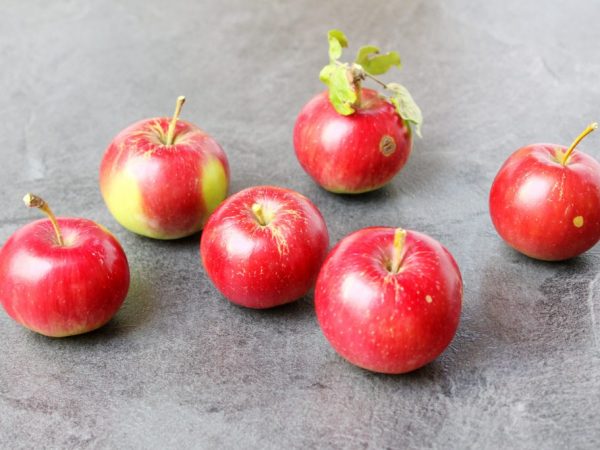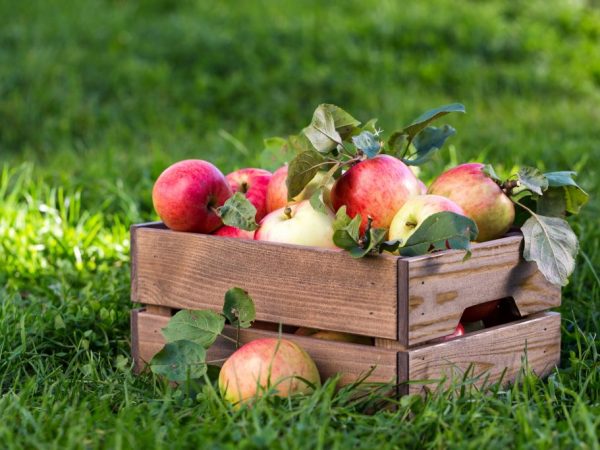Description of the apple tree variety Alesya
Apple tree Alesya is one of the most demanded varieties in our country. This crop is used for cultivation in both private and industrial horticulture. Due to its high winter hardiness, the hybrid is widespread not only in the South, but also in the regions of the Central and North-Western zone.
- Varietal characteristics
- Wood
- Fruit
- Yield
- Winter hardiness
- Disease resistance
- Pollinators
- Growing features
- Landing dates
- Care requirements
- Formation
- Fertilizers
- Watering
- Shelter for the winter
- Prevention of diseases and pests
- Flowering and fruiting
- Collection and storage
- Features of cultivation in different regions
- Conclusion

Description of the apple tree variety Alesya
Varietal characteristics
A medium-sized hybrid reaches no more than 4 m in height, so it is excellent for areas with a small area. Crown of compact shape, medium thickening.
Wood
According to the description, the Alesya variety is early ripe - the first fruits appear on the apple tree already 3-4 years after planting.
Distinctive features of culture:
- small shoots with smooth brown bark;
- spherical crown;
- emerald leaves, lanceolate, smooth without pubescence;
- flowers are small, pale pink color.
In the first years of life, a slow-growing tree reaches 1 m in height, over the next 10 years, the growth is 50 cm.
Wood has two important qualities:
- high resistance to scab and powdery mildew.
- with good care and proper planting, yields are consistently high.
Fruit
Fruits are round in shape, slightly flattened in the area of the stalk and in the upper part. The skin is smooth, medium density, glossy. Fruits are yellow in color with a crimson tint. The pulp is creamy, grainy, very juicy and sweet, contains a slight sourness. The aroma is weak.
The beginning of ripening occurs in October, but the fruits reach full maturity in mid-December. The crop can be stored on a tree for a long time and does not crumble.
Yield
Experienced gardeners recommend planting the tree as a medium-sized crop (50-120 cm in height).
When forming a crown and planting seedlings at a distance of 5 m from each other, you can achieve the maximum yield - about 20 tons of apples per hectare.
Ales' apples weigh about 120-180 g per rootstock; on a weak tree, they are smaller.
Winter hardiness
According to the description, the variety has good immunity and resistance to severe frosts, therefore it is successfully cultivated in the Moscow region, the Middle zone and the northern zone of our country.
Disease resistance
Powdery mildew and scab do not particularly affect the culture. A tree can get sick with them only in case of improper care and due to infection from a number of growing diseased trees.
Pollinators

Excellent harvest
The apple tree Alesya is pollinated by bees and with the help of trees with the same flowering period:
- Red Chief;
- Florin;
- Breburn;
- Bogatyr;
- Imrus;
- Cameo;
- Raika;
- Pinov.
Growing features
Considering that Alesya does not have large dimensions, she does not need a lot of space on the site.
Preference should be given to a sunny place where there are no winds. The soil is suitable loamy or sandy loam with a high content of nutrients.
For planting, select an area with a low acidity level. If desired, the soil can be deacidified by adding dolomite flour, powdered chalk or hydrated lime.
The apple tree does not grow well on waterlogged soil, it can rot and die from this, therefore, for planting it, choose a place with a deep passage of groundwater.
If you do not have this opportunity, you should provide the seedlings with good drainage from sand, pebbles and broken bricks.
Landing dates
In the fall, seedlings have more time to strengthen the roots and better survival in a new place. Autumn planting is often used in the southern regions of the country.
For regions with harsh winters, spring planting is preferable. Before the onset of the first frost, young trees will have time to get stronger.
Landing in the fall
Planting is carried out when the plants shed their foliage and throw all their strength into the growth and development of the root system.
- The soil is prepared about a month before the planned landing. Nutrients are added to the site - 1 bucket of last year's manure or compost, 1 kg of wood ash, 80 g of superphosphate and 40 g of potassium salt. Then they dig and level the soil.
- The depth of the holes is adjusted in accordance with the size of the root system (diameter 0.5 m).
- A wooden peg is installed in the center of the pit, which will further provide the plants with protection from breaking off by the winds.
- The roots of the plant are lowered into a hole, leveled, sprinkled with garden soil. The soil is compacted so that there are no voids. When planting, it is important that the root collar is just above the ground. So the plant will not rot and die.
- After planting, the plants are watered with warm, settled water and tied to a peg with twine.
- To preserve the moisture and temperature of the soil, the near-trunk zone is mulched with a nutrient component - peat or garden soil.
- After planting, the plants do not need to be fertilized, since nutrients will provoke the awakening of the seedling and its further growth, which is highly undesirable before the onset of cold weather.
- The first feeding of trees is carried out about 1.5-2 months - after the first autumn frosts. Complex preparations with a low nitrogen content are introduced. As the snow melts, the roots of the plant will receive all the necessary trace elements.
- In the southern regions, in snowless winters, the first feeding of autumn seedlings is carried out in early spring to eliminate the risk of their premature awakening.
Spring disembarkation
The right time is late April or early May, when the last frosts will pass.
They tear out the planting holes, fill them with a nutrient composition, which is used for autumn planting. To eliminate the risk of burning the roots, fertilizers are poured mixed with garden soil.
Then the soil is poured abundantly with water - 2 buckets of water are poured into one planting hole. A support is installed, then the roots of the tree are lowered, carefully straightened and sprinkled with garden soil. The soil around the trunk circle is trampled down, mulched with garden soil. With the help of twine, the seedling is tied to a support.
Care requirements

Proper care is needed for a good harvest
The subsequent care of young plantings consists of a number of activities.
Formation
This manipulation is necessary for the rapid development of the crown, fruiting and longevity. The first pruning of young trees is carried out one year after planting.
This is done in the spring - until the awakening of the vegetative buds or in late autumn - at the end of the growing season.
A sharp and sterile secateurs or scissors are used for this procedure. Young growth is shortened annually to stimulate the formation of new fruitful shoots.
Also important is the procedure for normalizing inflorescences and fruit ovaries. So the plant will not be overloaded and will yield large fruits. In the first year, all flower buds are removed, in the next 50%.
Fertilizers
For full-fledged growth and development, seedlings need a balanced diet, the composition should contain nitrogen, phosphorus and potassium.
With a lack of nutrients in the soil, the apple tree will grow slowly and will not begin to bear fruit soon.
Fertilizers are applied in several stages:
- in early spring, trees are fed with nitrogen-containing preparations;
- phosphorus and potassium are added before flowering;
- two weeks later, after the tree has faded, a complex composition (phosphorus, potassium and nitrogen) is introduced;
- the last feeding of the bushes is carried out in the fall after leaf fall with phosphorus-potassium fertilizers with a low nitrogen content.
Watering
For the whole season, you need to water at least 5 times: 4 buckets of water over a tree. The amount of moisture in the soil will determine not only the growth of the tree, but also its yield, the taste of the fruit.
Seedlings are watered in early spring, then before flowering and two weeks after it, and at the stage of fruit pouring. During the ripening period of the fruits, watering is stopped, since the apples can crack from excess moisture and after ripening will be watery.
The last watering to increase frost resistance is carried out in the fall - before the onset of cold weather.
After that, the soil is loosened to maintain its aeration. Regularly removing weeds and keeping the area clean will help prevent disease and parasites.
Shelter for the winter
Despite the fact that this Alesya has good winter hardiness, at the initial stage of growth he will need a good shelter.
Before the autumn frosts, the near-trunk zone is mulched, then sprinkled with fallen leaves, spruce branches or covered with roofing material. After the snow falls, the stem is sprinkled with a snowdrift.
Prevention of diseases and pests
For prevention purposes, gardeners carry out annual fungicide treatments. In early spring and late autumn, the crown and soil around the apple tree is sprayed with Bordeaux mixture or copper sulfate.
From the invasion of parasites, insecticides are used - Actellik, Aktaru or Fundazol.
The procedure is repeated several times with an interval of 10 days.
Flowering and fruiting
The flowering period of this tree, depending on the region of cultivation, is different. Usually, the budding stage occurs in April-May; in the Northern zone and regions of the Central zone, the dates may be slightly shifted (to mid-May).
The tree begins to bear fruit at 3 or 4 years after planting (when growing a clonal stock), with a seed stock - the first fruits appear at 5-6 years.
Collection and storage
The fruits of the Alesya apple tree have good keeping quality, so they can be stored until late spring. At the same time, the apples do not wrinkle, remain the same juicy, tasty and healthy.
To do this, the crop is placed in a cool place with good ventilation - cellar, basement. Before placing in boxes, each fruit is wrapped in paper or laid in layers, each covered with hay or cardboard.
At a temperature of 1-2 ° and a relatively low air humidity (60%), it will be possible to preserve the harvest until spring.
Features of cultivation in different regions
This versatile winter-hardy variety can be grown in almost any region of our country.
On the territory of the Moscow Region, the Non-Black Earth Region and in the Middle Lane, the tree grows well and bears fruit, does not need special care.
On the territory of Siberia, Altai and the Urals, there are often problems with freezing and incomplete ripening of fruits due to the short summer period. Therefore, trees need good shelter.
Conclusion
Due to its good survival rate and endurance in different climatic conditions, the Alesya apple variety has gained great popularity throughout the country.
This variety is especially appreciated by consumers due to its excellent taste and marketability.
Benefits:
- good keeping quality of fruits, which, when stored in a cellar or basement, can be stored until the end of April next year.
- consistently high yield;
- compact size.
According to gardeners' reviews, this apple tree has no drawbacks.


